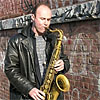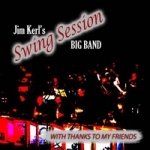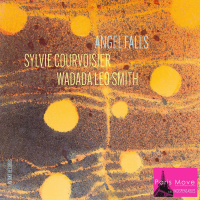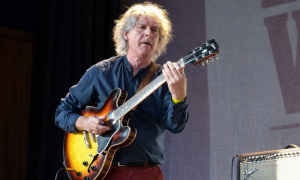Home » Jazz Articles » Live Review » Montreal Jazz Festival Day 10: July 7, 2007
Montreal Jazz Festival Day 10: July 7, 2007
Day Ten of the 2007 Festival International de Jazz de Montreal replayed the refrain of diversity, ranging from mainstream to fusion, from established artists to stars-in-the-making. It was also an ideal day to check out the third edition of the Montreal Musician and Musical Instrument Show (MMMIS) and its new offshoot, the Montreal Guitar Salon—two shows that demonstrate the Festival's desire to promote not only the artists and the music they make, but their instruments and technologies.
Day Ten was the final day of ticketed events (Day Eleven features the festival's traditional closing spectacle event) and was, as it drew to a close, a day to appreciate the festival's power-packed line-up and memorable programs but also to be saddened that it's nearly over. Additionally, there was an underlying, unsettling awareness that made the ending of the 28th edition of the Festival International de Jazz de Montreal all the more bittersweet: the pending closure of Le Spectrum, one of Montreal's most famous clubs for a quarter century.
Chapter Index
- MMMIS and Montreal Guitar Salon
- Chet Doxas Quartet
- Wayne Krantz Trio
- Esperanza Spalding / Russell Malone Quartet
MMMIS and Montreal Guitar Show
When the festival created the Montreal Musician and Musical Instrument Show, the goal was not only to provide a focal point at the festival for musicians to check out new gear and meet some of the manufacturers face-to-face, but to provide educational streams, such as workshops with festival artistsâïï¦even opportunities for non-musicians to participate in creating some remarkable music. With nearly 150 interactive activities, over four days MMMIS is not just a trade show, it's a one-of-a-kind show that's doubled in size since last year and, like FIJM, is rapidly becoming the new benchmark against which all similar shows are measured.
Walking through the exhibition at Complex Desjardins, it's hard not to be overwhelmed by the sheer number of manufacturers, ranging from small independents to large multi-nationals. From drums to banjos, guitars to saxophones, it's an opportunity to experience, first-hand, where the industry is heading.
It's also an opportunity to attend public interviews, instrumental workshops and, in the MMMIS GM Tent, experience open jams like the Brazilian Percussion and Djembé sessions. A new feature this year is a workshop that, in one hour, guarantees non-musicians will learn how to play Carl Perkins' "Blue Suede Shoes" on guitar. It may not be high art, but by encouraging those who've never played to take part, it encourages a deeper relationship between audience and artist, and perhaps is the first step in newcomers' becoming talented artists.

MMMIS / Montreal Guitar Show
MMMIS organizers had anticipated that the Montreal Guitar Show would be a success, but when there was such a large line-up on July 6 to get into the first day, they ended up opening the show an hour early. With over sixty luthiers, who build custom instruments that range in price from $3,000 to $45,000, it's all the more remarkable to consider that these are all successful craftspersons who, along with the manufacturering giants like Fender and Gibson, remain productively employed due to the popularity of the guitar.
It was a rare opportunity to experience the real craft of guitar-making with a wide variety of luthiers representing a wealth of individual innovation. Amongst them was Toronto's Linda Manzer, who is now into her third decade building custom-designed instruments for Pat Metheny, including the baritone guitar used on One Quiet Night (Warner Bros., 203) and the one-of-a-kind (actually, there are two) 43-string Pikasso Guitar that's he's used on albums including Imaginary Day (Warner Bros., 1997) and Trio Live (Warner Bros., 2000).
But that's only part of the story. One luthier was also a woodcarving artist, and each guitar he builds has a unique carving on the back of the body. Others challenge convention through designs that would appear to be unworkable—until they materialize. Sound booths were provided so that interested attendees could try out a guitar insulated from the noise of the crowd—and, perhaps, make some joyful noise themselves.
With the growth of MMMIS and its offshoot Montreal Guitar Show, FIJM continues to expand its purview, with little appearing to be out of its reach.
class="f-right">
Another strength of FIJM is its commitment to the vibrant Montreal jazz scene. Unlike other festivals which, while creating opportunities for local acts to perform, typically put them in less-than-favorable places, FIJM regularly puts local musicians on equal footing with their international colleagues. The 6:00 pm Jazz D'Ici series at the festival's most intimate venue, the Gesu theatre, has provided a wonderful place for local musicians to reach out to the festival's international audience.
Amongst the many fine and stylistically diverse artists in the Montreal area, tenor saxophonist Chet Doxas and his quartet stand out. Still only in his mid-twenties, Doxas' debut, Sidewalk Etiquette (Justin Time, 2006), was a refreshing mix of introspective ECM-like abstraction, complex thematic twists and turns, and some flat-out swinging. Drawing on the record plus some new material, Doxas' quartet demonstrated even greater flexibility on location than on the disc.
Pianist John Roney is a leader in his own right, and has run the late night jam sessions at the Montreal Hyatt Regency hotel, where one never knows who might show up to sit in. His Rate of Change Effendi, 2006) was another surprising debut, although its generally introspective nature represents only a part of what Roney is all about. With Doxas he was often far more outgoing, demonstrating a focused approach to soloing that resulted in strong narratives rather than merely a stream of disconnected ideas.

l:r: John Roney, Chet Doxas
Bassist Zack Lober is also a part of Roney's trio and is a player who values economy, making every note count whether as an accompanist or soloist. Drummer Jim Doxas—Chet's brother and the third member of Roney's trio—is one of the most exciting drummers to come out of Canada in years. Possessing a seemingly endless wellspring of ideas, he nevertheless has the kind of ears that, like Lober, value meaning over virtuosity, and is as content with simple cymbal washes as he is playing more propulsive and expressionist attacks. In some ways his appearance of abandon resembles Brian Blade's and, like Blade, there's considerable thought underlying the apparent freedom, though the musical idea isn't contrived or over- analyzed. Lober and Jim make a terrific rhythm section, responsive but equal partners in the quartet who are just as likely to push the music into new areas as they are to follow Roney or Chet's lead.
Chet's a fine saxophonist with considerable promise. Capable of great virtuosity, he's assimilated the cerebral and economical side of Wayne Shorter's playing into a personal voice that is stretched by his varied and complex writing. That the members of this quartet work together in other contexts—Lober and Jim Doxas in Roney's trio and the electronica-centric Byproduct, featuring Lober and the Doxas brothers— means that, when they come together as the Chet Doxas Quartet, there's a collective chemistry along with a divergent approach and the open-mindedness that makes anything possible.
class="f-right">
Wayne Krantz is a guitarist known to many musicians, but has yet to find his way onto the radar of the larger listening public. Still, anyone who's heard saxophonist Chris Potter's remarkable Underground (Sunnyside, 2006) has heard him run the gamut from raucous, gritty edge to ethereally subtle nuance. He's also toured with Steely Dan, so there are many who've seen him play but just don't know who he is.
For the final night of a three-night residence at Metropolis (the first was solo, the second a duo with his bassist, Paul Sokolow), Krantz featured his working trio with Sokolow and drummer Cliff Almond on a ninety- minute set that was like manna from heaven for some, and a new addition to the biblical ten plagues for others.
The show was loud. With Sokolow and Almond creating an almost relentless ground-shaking undercurrent behind Krantz that was, at times, more tumultuous maelstrom than clear pulse, and Krantz's pushed-to-eleven Stratocaster and Marshall Stack, the feeling, at times, was an all-out assault on the senses. Krantz's often long-form writing consisted of radical shifts in tempo and feel, cued with the slightest of nods to the rhythm section, resulting in music that, rather than catering to the audience in any way, dared it to come along for a ride filled with twists and turns.

Some folks chose not to. Krantz, who appeared somewhat introverted but, when speaking to the crowd, had a relaxed rapport, said, "I'm seeing people who feel like they just have to get outta here, it always happens so it's ok but I'm glad a lot of you have chosen to stay."
The trio performance represented a milestone for Krantz, who has been playing weekly with various incarnations of his trio at the same New York club (other than when he's on tour) for the past decade. With that gig ending, his Montreal performance will be the last one with the trio for some time. Krantz may play with rock energy, and use all kinds of processing—distortion, delay, wah wah, ring modulation, pitch shifting and more—but the complex nature of his writing and the abstruse way that he develops his solos means that he's often difficult to grasp, and there must be considerable obstacles to finding a forum and venue for his music.
Still, the audience that stayed was treated to an unusual combination of virtuosity all around, take-no- prisoners grooves, and another player at FIJM who seems to have an endless supply of inspiration and creativity. Krantz's hard-to-approach compositional and performing styles may limit the audience that's ready for him, but for those who are, his Montreal performance was a rewarding experience.
class="f-right">
Esperanza Spalding / Russell Malone Quartet
Guitarist Russell Malone's show, featuring the remarkable bassist/vocalist Esperanza Spalding as the opening act, was a highlight of the 2007 FIJM. It was, however a bittersweet experience for those who have spent any time at Le Spectrum over the years. A club venue with terrific sound and a capacity for approximately nine hundred, it's been not just a key venue at FIJM since it was opened twenty-five years ago: it's been a vital part of the broader Montreal music scene, bringing in a variety of acts ranging from metal to pop, singer/ songwriter to jazz instrumentalists including Oregon, who performed there in February 2007, and more. The entire block is slated for demolition later in the summer, and there are conflicting stories about whether or not a new club will be part of the picture.

Regardless, the history of an institution can't be ignored, and the choice of Malone as the final jazz show to take place at Le Spectrum was an inspired one. As was the decision to put Spalding in as opening act, though she'd already played two free, outdoor shows and guested with Richard Bona on the second day of his four-day Invitation Series. Spalding came to Montreal in 2006 with Joe Lovano, but more impressive than her performance was her sitting in at one of the late-night jam sessions, hosted by Montreal pianist John Roney and his trio with bassist Zack Lober and drummer Jim Doxas. Only twenty-two, Spalding is now on staff at the Berklee College of Music, paralleling another young artist who taught at the renowned school at a young age and has since gone on to become one of the biggest names in jazz: Pat Metheny.
Whether or not Spalding reaches the same height of popularity, her brief performance made it clear that she's a serious triple threat: a fine bassist with a robust tone, a strong sense of groove and richly lyrical solos; a powerful singer, capable of the hard-to-imagine combination of scatting and bass playing; and a notable writer, whose material made up most of the set list that kept her and her trio—keyboardist Leo Genovese and drummer Lyndon Rochelle—on their toes throughout. Completely without pretense, Spalding engaged the crowd with a powerful voice capable of greater subtleties and a refreshingly non-melismatic vocal approach in these days of American Idol-like excess. She possesses a voice marked by purity and a sweet, understated vibrato of great effect, because she used it to enhance, rather than obscure, her gymnastic ability to develop powerful vocal solos.
Wherever direction her career path takes, she undeniably possesses all the components to become a significant artist on the international jazz scene. Only time will tell.
Following a short break, Malone took to the stage, launching immediately into a fiery original, "He Said What," that quickly established his remarkable skill. A mainstream player who has clear precedence in Wes Montgomery, George Benson and, to a limited degree, Pat Martino, Malone remains unique in the world of straight-ahead jazz guitarists. Few jazz guitarists use vibrato, but Malone's B.B. King-like fast vibrato created a unique combination of blinding technical virtuosity and unexpected physicality.
Malone's quartet has been around for a couple of years and features in-the-pocket bassist Tassili Bond, powerhouse drummer Jonathan Blake and pianist Martin Bejerano, heard recently at the Ottawa International Jazz Festival with drum legend Roy Haynes. The quartet is featured on Live at Jazz Standard, Vol. 1 (MaxJazz, 2006) and the soon-to-be-released follow-up, Volume Two (MaxJazz, 2007). While Malone, in one of his engaging introductions, described how each member came to the band, he didn't have to say what was perfectly clear the moment the group played: that this is a potent band with terrific energy and commitment, an ability to shift feels on a dime, and the broad stylistic scope and supporting skills to play both within and outside the American mainstream tradition.

l:r: Russell Malone, Jonathan Blake
Malone's technical ability has few peers. Blinding speed aside, he's capable of the kind of chordal harmonics first introduced by the late Canadian guitarist Lenny Breau, but he's taken the technique one step further, as demonstrated on his solo intro to "More Than You Know." And while he sticks mainly with a pick, when he does finger-style picking, as he did on a beautiful intro to "Unchained Melody," it becomes clear just how much potential yet remains for this gifted player.
With impressive solo after impressive solo—from everyone in the band—there was no question of leaving without an encore. When he asked what the audience wanted to hear and someone yelled out "blues," Malone and his quartet launched into a booty-shaking barrelhouse blues. Even more in B.B. King mode, Malone adjusted his amplifier so that his normally warm hollow body electric tone was more appropriately sharp and pungent. His extended solo once again demonstrated the kind of breadth that suggests how, while he may be viewed as the mainstream now, where he'll go in the future is wide open.
FIJM could not have chosen a better double bill to close Le Spectrum, with many of the people in the capacity crowd leaving with a sense of ambivalence: exhilaration from the performance combined with a sense of loss that this great Montreal institution will be demolished in a few short weeks.
Tomorrow: Festival Closing Party with Rachid Taha, Festival Wrap-Up.
Visit Chet Doxas, Wayne Krantz, Esperanza Spalding, Russell Malone and the Festival International de Jazz de Montreal on the web.
Photo Credit
John Kelman
Day 1 | Day 2 | Day 3 | Day 4 | Day 5-1 | Day 5-2 | Day 6 | Day 7 | Day 8 | Day 9 | Day 10 | Day 11
Tags
PREVIOUS / NEXT
Support All About Jazz
 All About Jazz has been a pillar of jazz since 1995, championing it as an art form and, more importantly, supporting the musicians who make it. Our enduring commitment has made "AAJ" one of the most culturally important websites of its kind, read by hundreds of thousands of fans, musicians and industry figures every month.
All About Jazz has been a pillar of jazz since 1995, championing it as an art form and, more importantly, supporting the musicians who make it. Our enduring commitment has made "AAJ" one of the most culturally important websites of its kind, read by hundreds of thousands of fans, musicians and industry figures every month.























